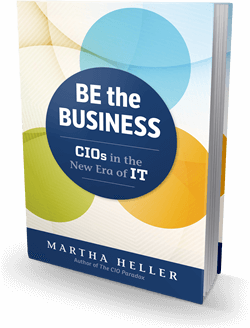When technology belongs to everyone, what does that mean for the CIO?
In 2015, I started asking every CIO I met the same question: “How has your role changed in the last five years?” Regardless of industry or company size, the answers shared a theme. “I have moved from the back office to the front office. I am less operational and more strategic. I contribute directly to the revenue stream. I am a valued business partner.”
So, I pressed on. “How have you changed your IT operating model to support this changing role?” This is where things got interesting. CIOs talked about restructuring IT around services and products, as opposed to applications and projects. They talked about creating an “investment management culture” among their business partners, who traditionally just ate what IT fed them. They described new approaches to vendor management and a greater appetite for allowing their business partners to leverage new IT suppliers.
The CIO's Role in the Digital Business
From all of these conversations, I began to see a pattern: CIOs are breaking down the walls between IT and the rest of the business. They are recognizing that when technology, all of the sudden, belongs to everyone, they must find ways to distribute IT investment decisions, innovation, development and adoption across the enterprise. They must engender in their teams a desire to pave the moat around IT, to embed IT in every facet of their companies, and to let go of control.
 The most forward-looking of these CIOs are refusing to cede “digital” to a brand new executive; they are taking a central leadership role in digital transformation. They are re-conceptualizing shadow IT as “end user innovation,” and they are using their end-to-end operational view to free their business partners from their vertical prisons so that they can look up and out at the future together. Just as these CIOs are “being the business,” they are allowing “the business” to be IT.
The most forward-looking of these CIOs are refusing to cede “digital” to a brand new executive; they are taking a central leadership role in digital transformation. They are re-conceptualizing shadow IT as “end user innovation,” and they are using their end-to-end operational view to free their business partners from their vertical prisons so that they can look up and out at the future together. Just as these CIOs are “being the business,” they are allowing “the business” to be IT.
As I reviewed the reams and reams of interview material that I produced from the more than 40 generous CIOs who gave me their time, I saw still more patterns. CIOs who were successfully capitalizing on the new era of IT had a lot in common:
- They all had cogent approaches to developing blended executives, those gorgeous creatures who can lead both in IT and a business function.
- They were working hard to educate their executive committee on the true costs of IT.
- They were changing their role from one of enabling a business strategy handed to them to playing an active role in defining that strategy, and
- They were finding ways to deliver IT value at a break-neck pace.
So, I wrote the book. When I set out, I had the goal of providing the perfect prescription for IT leadership in a digital world. When I was done, I would provide to CIOs -- in one quick read -- a blueprint for creating an operating model and a culture that allows IT to rise to all of its transformational potential.
But when I lifted my fingers from the keyboard about an hour before my manuscript was due to my publisher, I realized that I had been on a fool’s errand. When it comes to moving from an “industrial economy mindset” of walls between departments and companies to a “digital economy mindset” of permeable boundaries, partnerships, and cross-functionality, we have only just begun.
I am extremely proud of the stories, philosophies, and advice that make up every chapter of Be the Business, but I know that there is so much more to say. As such, I ask you to consider this book a “minimal viable product,” which I submit to you, my longtime partners in developing thoughtful ideas about IT leadership. As we discuss these ideas together at conferences and online, I look forward to learning how you are evolving your own role and transforming IT from a department to an enterprise capability.





Add a Comment